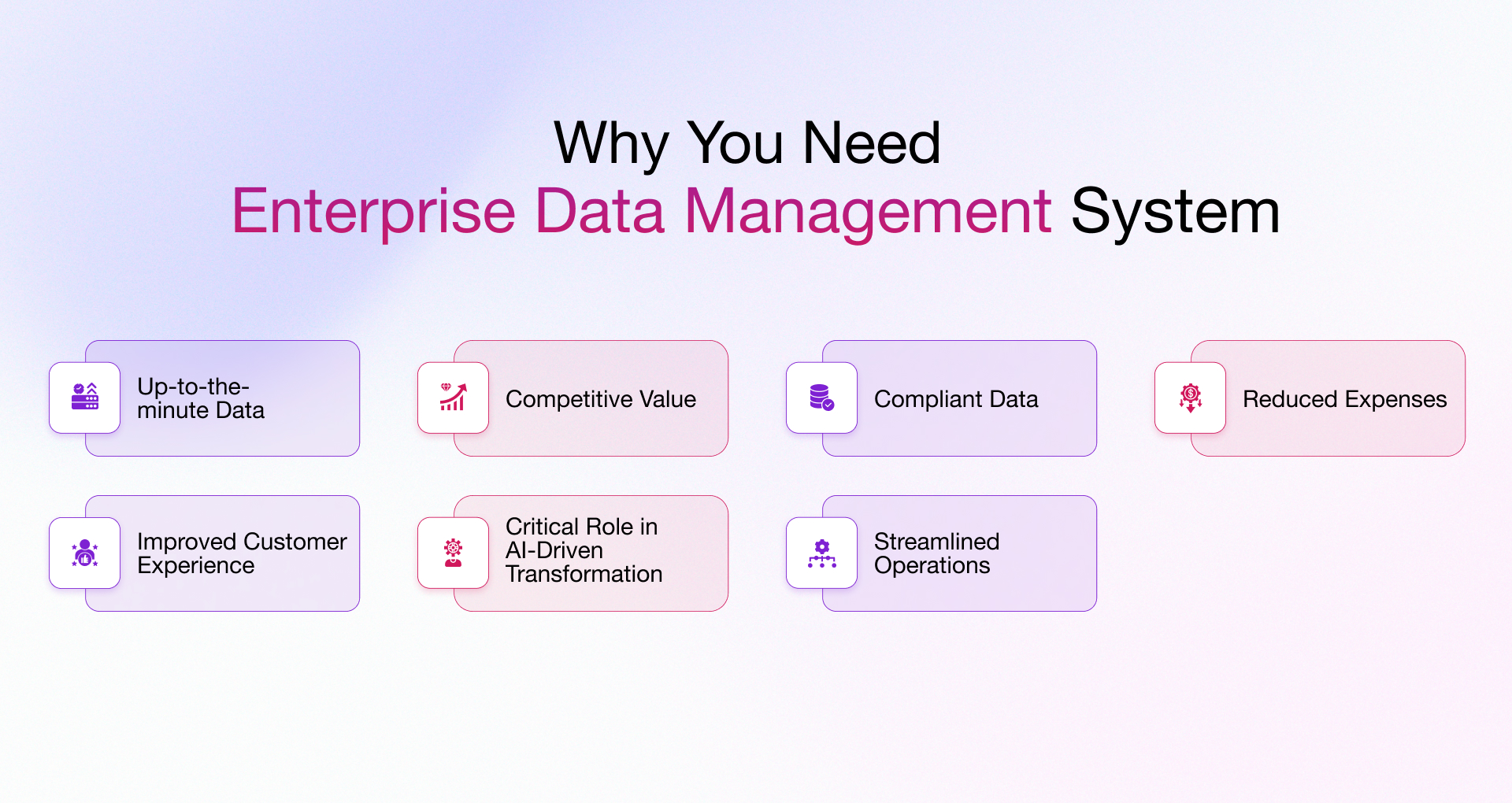Data is the currency that drives businesses worldwide! It comes in many forms like images, videos, graphs & charts. In the modern context, Enterprises often struggle to adopt, integrate, and manage data that moves through their systems. But, without a holistic data management strategy, they cannot unlock the full potential of their data ecosystems. Here comes the need to leverage the capabilities of enterprise data management (EDM).
If your company was fast enough to adapt data management, implementing proactive measures over the last few years, you are better than handling data tide. Unfortunately, many enterprises didn’t have the same foresight & now they struggle to get a handle on their data, which is growing and changing daily.
So, whether you’re just getting started or honing your strategy, here’s what you need to know about enterprise data management. This blog will discuss EDM, its use, essential elements, processes, challenges, benefits, and more.
What is Enterprise Data Management?
It is the process of organizing, governing, and maintaining an organization’s data assets. EDM encompasses a set of strategies, policies, and technologies that help organizations manage their data as a valuable asset and ensure that it is accurate, complete, and reliable.
EDM aims to improve the quality, accessibility, and usability of an organization’s data. It involves establishing a framework for data management, including policies and procedures for data collection, storage, analysis, and distribution. It also includes implementing tools and technologies for managing data, such as data warehouses, data governance tools, and data integration platforms.
Enterprise data can take many forms as it is the totality of the digital information flowing through an organization. Broadly it would include structured data, such as records in spreadsheets and relational databases, and unstructured data, such as images and video content. Here are some common types of enterprise data forms:
Customer Data Forms:
- Captures customer information, such as name, address, email, phone number, and other contact details
- Information is used for marketing, sales, and customer service purposes
Employee Data Forms:
- Collect information about employees, such as name, address, date of birth, social security number, job title, and other employment-related data
- Information is used for payroll, benefits, and other HR-related purposes
Product Data Forms:
- Capture information about products, such as product name, description, SKU number, pricing, and other product-related data
- Information is used for inventory management, sales, and marketing purposes
Financial Data Forms:
- Collect financial information, such as revenue, expenses, profit and loss, and other financial data
- Information is used for budgeting, forecasting, and financial reporting purposes
Marketing Data Forms:
- Capture marketing data, such as campaign performance, customer demographics, and other data related to marketing initiatives
- Information is used to improve marketing strategies and campaigns
Survey Data Forms:
- Collects survey data, such as customer feedback, market research, and employee satisfaction surveys
- Information is used to make data-driven decisions and improve business operations.
Overall, enterprise data forms are critical tools for businesses to capture and manage different data types from various sources.
Why is Enterprise Data Management Important?
Enterprise Data Management (EDM) is essential because it consolidates scattered data into a single, clean, secure, and actionable source of truth. It helps you make faster, smarter decisions, stay compliant, and reduce costly errors. The primary purpose of any enterprise data management software is to eliminate existing and potential issues arising due to the mishandling and bungling of data.
Did you know?
The data volume managed by businesses worldwide will grow 61% (175 zettabytes) by 2025, says IDC report. Enterprises not using EDM effectively will run the risk of non-compliance and may also have a hit on revenue. In comparison, effective data management will ensure business sustainability & growth.
Here are six more reasons why your business needs enterprise data management:

1. Up-to-the-minute Data
Unmonitored data loses its authenticity and resourcefulness for your business. EDM ensures that your data is accurate, relevant, and reliable.
2. Competitive Value
Centralized, structured, and usable data is valuable. EDM helps you gain vital governance and access to a single, authorized source hosting quality data for analytics and Business Intelligence (BI).
3. Compliant Data
Increased data volume and variety make mitigating compliance risks difficult. Proper data management enables you to evaluate the risk level and comply with rules and regulations.
4. Reduced Expenses
You spent considerably on the staff to cope with low-quality data. They could focus on value-add processes instead! Effective data management or data engineering services can help reduce these costs.
5. Improved Customer Experience
A minor error could damage your online reputation with a negative customer review. Robust data management helps you better serve customers and instills long-term loyalty.
6. Critical Role in AI-Driven Transformation
EDM also plays a critical role in enabling AI-driven transformation. Clean, well-organized data sets the stage for building accurate predictive models, automating workflows, and uncovering real-time insights. Simply put, without strong data management, AI can’t function at scale or deliver reliable outcomes.
7. Streamlined Operations
Leveraging the potential of data analytics, your data managers can identify areas for improvement. With access to actionable data, they can make informed operational decisions, especially for data security and compliance obligations.
Benefits of Enterprise Data Management
Effective enterprise data management provides wide-reaching benefits. It helps you define and enforce rules and regulations that unify your data across workflows. This standardization brings your business the following advantages:
- Reduces cost through improved operational efficiencies
- Helps create a data-driven culture
- Accelerates the pace of launching new products
- Opens up revenue sources with new capabilities & services
- Creates new space for innovation and disruption
- Enhances responsiveness to market changes & consumer needs
- Eliminates the risk of losing mission-critical business data
- Saves time & resources while avoiding duplication of information
- Sets a solid foundation for monetizing data
- High-quality, structured data fuels machine learning models and makes AI implementation more effective. EDM helps businesses transition from experimentation to production more quickly.
The mounting pressure to implement enterprise data management solutions is not a fad. You have real operational needs, like making data easily accessible and convenient. So, why delay embracing the change that benefits and transforms your business? Now is the time to adapt and take advantage of EDM.
Enterprise Data Management in the Age of AI and Analytics
AI and analytics are only as powerful as the data behind them. Without clean, consistent, and well-governed data, even the best AI models fail to deliver value. Enterprise Data Management (EDM) provides the structure needed to support these technologies by ensuring data is accurate, accessible, and compliant.
With built-in capabilities like metadata management, data lineage, and automated preprocessing, EDM prepares your datasets for responsible AI use. It helps eliminate bias, improves model accuracy, and ensures compliance with data governance standards.
For businesses aiming to scale AI and analytics, EDM is not just support; it is the foundation that makes scalable, trustworthy, and insight-driven outcomes possible. Explore how our AI services build on strong data foundations to drive intelligent transformation.
Components of Enterprise Data Management
The key elements of Enterprise Data Management (EDM) include data governance, data quality, data integration, data architecture, data security, data lifecycle management, and other related aspects. Together, these components ensure that enterprise data is accurate, accessible, secure, and aligned with business goals, enabling smarter decisions and regulatory compliance. The eight core enterprise data management components are as follows:
- Data Governance: This is the foundation layer of data management and includes creating records that define all the critical policies, procedures & roles for combining data from different sources. It streamlines information flow, protects user privacy, and ensures compliance with applicable rules.
- Data Integration: The data stored in a centralized repository is then helpful to all the stakeholders across the board. It ensures that the right people are delegated the correct responsibilities by defining a structure for internal & external accountabilities.
- Master Data Management (MDM): It is the set of technology tools and process that manages, stores, organize & sync the master data of the business. This offers a consistent view of all the disparate data lying in silos –sales, marketing, CRM, or more.
- Data Architecture: It creates guidelines that help enterprises streamline data extraction, integration, transformation, and modeling. The goal of setting up a functional architecture is essentially organizing and securing the operational infrastructure. This is where all the data is stored and manipulated without compromising security.
- Data Warehouse & Business Intelligence: A data warehouse is a platform that stores a massive amount of structured data. The data could be from multiple sources and valuable for data mining. It restructures the information into a suitable format for further analysts to derive actionable insights. Business intelligence implementation enables the end-user with insights to make smarter, data-driven decisions for better business outcomes.
- Metadata Management: It entails framing standard procedures that govern the management of data definitions & related information.
- Data Privacy: It ensures that sensitive information is collected, processed, and shared in compliance with global data protection laws, such as the GDPR and CCPA. It protects customer trust, minimizes legal risk, and reinforces your brand’s reputation by embedding privacy into every layer of your data strategy.
- Data Lifecycle Management: This element focuses on managing data from creation to deletion. It ensures that data is stored, archived, and disposed of in accordance with business and compliance requirements. Effective lifecycle management reduces storage costs, mitigates risk, and ensures that only relevant, up-to-date information powers your business decisions.
After accounting for these key enterprise data management elements, you can chalk out a future strategy.
Enterprise Data Management Strategy

Businesses often ask how to create a strategy for successful enterprise data management. No one-size-fits-all strategy is proven to work efficiently for every enterprise. A tailored roadmap based on your specific needs could help. Here are the steps to creating an effective strategy based on our decade long experience and expertise:
- Evaluate the existing data management system: You should collect and analyze the information related to the company’s size, nature, goals, processes, and scope. Know which subsystems the system comprises and how they are interrelated. Understand the pitfalls that decelerate the flow of data between processes. Also, analyze the inputs & outcomes of each subsystem.
- Gain a clear understanding of your organizational goals: Ask yourself what products you want to create as outcomes of your EDM and how you intend to use them.
- Implement enterprise data governance with established standards and procedures: You must identify activities to construct a conceptual structure that guides high-quality data product development. Define the rules and regulations for every subsystem and process. Determine how to execute each identified activity.
- Define the teams and delegate their responsibilities: You must allocate roles and activities to specific teams and specify individual responsibilities within departments. Also, define horizontal and vertical hierarchy across functions.
- Implement an agile enterprise data architecture: You need to decide on the hardware & software technologies you intend you use. Determine the different formats of data that are to be collected and distributed. Create data pipelines to automate processes and specify how data will change during the transformation.
- Implement data management tools and technologies: Implement data management tools and technologies that support your data management policies and procedures, data governance framework, and data architecture. It may include data integration tools, data quality tools, metadata management tools, and data security tools.
- Define data analytics, AI, and reporting requirements: Identify the data sources and formats that will support your analytics, machine learning models, and reporting needs. This ensures your data strategy aligns with both real-time BI and future AI applications.
- Develop a data management roadmap: Develop a data management roadmap that outlines the key initiatives and milestones required to implement your data management strategy. This roadmap should align with your business goals and objectives and include a timeline, budget, and resource plan.
- Keep employees and partners up-to-date about system changes: You need to educate your teams on structural, technological, and system updates. Also, notify all external stakeholders about the new policies, procedures & standards and how they will affect them.
- Implement and monitor your strategy: Implement your data management strategy and monitor your progress against your data management roadmap. It will help you identify areas that need improvement and adjust your plan as necessary to ensure that it continues to support your business goals and objectives.
Enterprise Data Management Best Practices
Enterprise Data Management (EDM) organizes and maintains data assets across an organization to support effective decision-making and improve business performance. Below are some of the EDM best practices following our experience working on diverse data projects across industries.
- Establish a data governance framework: Develop policies, procedures, and standards for managing data across the organization. It includes defining roles and responsibilities, data quality rules, and data security requirements.
- Identify and prioritize data assets: Understand which data is most critical to the organization’s success and prioritize its management accordingly. It includes defining the data’s lifecycle, from creation to archival, and determining appropriate retention policies.
- Ensure data quality: Implement data quality controls to ensure data is accurate, complete, and consistent across systems. It includes developing data validation rules, data cleansing processes, and data profiling techniques.
- Integrate data silos: Connect and integrate data across siloed systems to provide a unified view of data across the organization. This includes developing data integration processes, such as Extract, Transform, Load (ETL) & data virtualization.
- Maintain data security: Develop and implement policies and practices to protect sensitive data from unauthorized access, use, and disclosure. It includes developing access control policies, implementing encryption, and monitoring data access and usage.
- Foster a data-driven culture: Promote a data-driven culture across the organization by encouraging data literacy and building data-driven decision-making processes. This includes developing training programs, promoting data analysis tools, and encouraging data-driven decision-making.
- Continuously monitor and improve: Establish metrics and key performance indicators (KPIs) to measure the effectiveness of EDM processes and constantly improve them. This includes regularly monitoring data quality, security, and integration processes and making necessary adjustments to improve performance.
- Design for AI-readiness from the start: A future-ready EDM strategy doesn’t just support BI and reporting—it lays the groundwork for machine learning and AI adoption. Maintain clean, labeled, and unbiased datasets. Capture metadata, automate preprocessing, and ensure compliance across your model lifecycle. Consider starting with an AI Readiness Assessment to evaluate gaps in your current setup.
By implementing these best practices, organizations can effectively manage their data assets and use them to make informed business decisions, improve operational efficiency, and drive business success.
Enterprise Data Management Challenges
Organizations in a better position to mobilize their data assets and power mission-critical business initiatives will gain a distinct edge in the coming years. Those that fail to revamp policies and put systems in place will struggle in the veritable sea of old and new data. When data management is unorganized, the enterprise can face many challenges. Here are a few of them:
- Operational inefficiencies and data inaccuracies: Disconnected systems and manual data handling often lead to errors and inefficiencies. Automating data workflows with integrated EDM platforms ensures real-time accuracy and speeds up operations.
- Conflicting data and lack of trust in assets: When departments operate in silos, inconsistent data versions emerge. A centralized data governance model enforces standards and ownership, restoring trust in your data.
- Inconsistent reporting and unreliable insights: Poor data quality can skew reports and mislead decision-makers. Implementing robust data quality checks and validation rules helps maintain consistency across reporting systems.
- Wasted time reconciling data and formats: Teams lose valuable hours trying to align conflicting data sets. Standardizing data formats and consolidating storage systems eliminates redundancy and accelerates access.
- Fractured internal collaboration and communication: Data friction often leads to confusion and tension across teams. Clear data stewardship roles and a unified data catalog create transparency and accountability.
- Customer dissatisfaction and poor experiences: Inaccurate or outdated data affects personalization and responsiveness. Real-time data integration and lifecycle management keep customer data fresh and reliable.
Data management may be daunting, and you may face challenges in defining, organizing, and storing assets. However, enterprise data management solution development can be accomplished with the support of the right technology partner that is backed by proven experience, the right strategies, and a competent team.
Enterprise Data Management vs. Master Data Management
Organizations have business rules for departments like operations, sales, and marketing. Therefore, following those rules, if they centralize and manage data in master data, this process is called Master Data Management (MDM). For instance, financial institutions trading in securities create a security master for data management. Across industries, when a company needs to master entry-level data with critical touchpoints, they utilize the MDM terminology for data management.
In broad terms, EDM and MDM are the same because both represent the process of standardizing, managing, and governing mission-critical data.
However, there’s more to Enterprise Data Management, as it also provides analytical information to drive decision-making and strategic business planning. It ensures that the data running through your business systems and applications are accurate, accessible, and reliable. So, when an organization adopts EDM, MDM becomes one of its key elements (as discussed in the earlier section).
Build a Robust Enterprise Data Management System with Rishabh
As an experienced data engineering services provider, we offer end-to-end EDM services from data acquisition, cleansing, interpretation, deduplication, and structuring.
We can build ETL (Extract, Transform, Load) processes, data pipelines, data lakes, data warehouses, and BI (Business Intelligence) capabilities. Being certified AWS (Amazon Web Services) and Microsoft Azure partners, we can help you with cloud deployment, cloud migration, cloud-native application development, and data modernization.
And that’s not it. Our team is adept at leveraging the benefits of many tools and technologies.
Tools & Technologies We Use
Cloud Platforms
- Amazon Web Services (AWS)
- Microsoft Azure
Data Integration
- Azure Data Factory
- Apache Kafka
- Microsoft SQL Integration Services
Application Development
- Apache TEZ
- MongoDB
- Couchbase
- Apache Drill
Data Warehouse & Storage
- Amazon DynamoDB
- Amazon Elasticsearch
- Amazon RDS
- Amazon REDSHIFT
- Azure Synapse Analytics
- Snowflake
- Microsoft SQL Server
- MongoDB
- Redis
- Apache Kudu
Big Data
- Apache Spark
- Hadoop
- Casandra
- Kafka
- Hive
- Apache Zookeeper
- Azure Cosmo DB
- Presto
- Apache HBase
- Apache Storm
Data Visualization
- Microsoft SQL Server Reporting Services
- Tableau
Programming Languages
- C++
Success Story
Case Study: Cloud-based Data Warehouse System

A US-based F&B & Resort management company wanted to eliminate data silos and efficiently manage disparate data from 20+ sources. It was an outcome of multiple acquisitions with varied data source integration. They tried to unify their business data and merge numerous business applications, including PMS, POS, analytics, inventory, etc.
With a consultation-led approach, we created & executed a detailed project roadmap for developing an enterprise data management platform. Right from Understanding data, Operational Data Store (ODS), ETL and Data Warehouse creation, BI integration, and cloud deployment.
Key takeaways;
- 50% increase in workflow efficiency
- 40% reduction in data quality issues
- 99% accuracy of business understanding available on-the-go
Read more about how the developed cloud-based data warehouse system enabled the US-based hospitality giant helped the US-based hospitality giant to manage disparate data from 20+ sources & derive valuable insights as per their needs.
Concluding Thoughts
Implementing an enterprise data management solution correctly helps make profitable, evidence-based decisions. It enables seamless integration of actionable insights into developing your products & services.
Efficient data management streamlines the data flow and work culture, improving internal and external communication. EDM saves you considerable time & money by eliminating the stress, hassles, and costs of coping with low-quality data.
If you want a new EDM system or to enhance an existing one, we can help you. Every enterprise is data-driven! And so, now is the best time to make the most of this system.
FAQs
Q: We already have data systems—how is EDM different or necessary?
Having data systems isn’t the same as managing data strategically. EDM connects the dots between your tools, standardizes data use across teams, and ensures everything runs on clean, trusted data. It eliminates silos and turns scattered systems into a single, high-value data ecosystem.
Q: Is EDM only for large enterprises or can mid-size companies benefit too?
EDM isn’t just for Fortune 500s. Mid-size companies often deal with the same data chaos, just with fewer resources. A scalable EDM approach helps you grow smarter, avoid costly errors, and compete with agility. It’s not about size. It’s about control.











 30 Min
30 Min


